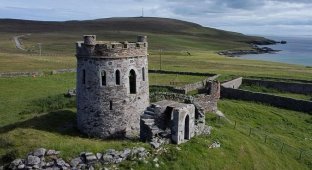Liveden New Build - a unique architectural object of a noble era (9 photos + 2 videos)
Lyveden New Bield is an unfinished Elizabethan summer house located in the parish of Aldwinkle in North Northamptonshire, England. 
The National Trust, which currently owns the building, lists it as a "building of exceptional interest" due to the religious symbolism in its architecture. 
Liveden New Build was built by Sir Thomas Tresham, who was a devout Catholic, making him a threat to the Protestant faith of Queen Elizabeth I. For his beliefs, Tresham was often imprisoned and forced to pay huge fines, which he willingly paid in order to maintain his Catholic beliefs and practices.
Tresham also embodied his beliefs in architecture. His most famous folly is the Triangular Lodge near Rushton, which is full of religious symbolism. His second building is the unfinished Lyveden New Build, located on the site of Tresham's second home, Lyveden Manor House, also known as Lyveden Old Build. 
Like the Triangle House in Rushton, the New Build has a religious design full of symbolism. The facades, designed on a plan resembling a Greek cross, are distinguished by strict symmetry. The building with transom windows has two storeys above a raised basement. Each floor has three rooms with a staircase in the southern projection of the cross. The bay windows have five sides (this number is a common symbol of Jesus and Mary). The building's façade is decorated with religious friezes. 
New Build was never intended to be Tresham's main home, but rather a retreat for him and a few servants while his main house was being put in order. It has a large hall and sitting room on the ground floor, a kitchen and creamery in the basement, and a bedroom on the upper floor. 
The mansion was never completed. Sir Thomas Tresham died in 1605 after decades of religious persecution had greatly depleted his wealth. His son Francis Tresham inherited the estate, but was implicated in the Gunpowder Plot that same year, along with his cousins Catesby and Wintour.
Francis's mother ran the estate until her death in 1615. Francis's son Lewis Tresham then squandered the remaining family wealth. The estate was eventually sold after his death in 1643. 



























